It seems a lot of questions, concerns, information and misinformation exists related to the LS7 valvetrain issues.
We felt it might be helpful to our dealers and customers to summarize what we have learned over time about these issues.
(Want to skip straight to our Ported OEM LS7 Cylinder Head Package?)
-
 GPI – LS7 HeadsFrom: $1,195.00
GPI – LS7 HeadsFrom: $1,195.00
THE INFAMOUS CONCERN
I just purchased a C6 Z06 and I am reluctant to drive it before getting the “heads fixed”…
THE HUNT FOR KNOWLEDGE
The concern often seems to arise from the “Forum Chatter” – where a high percentage of customers who actually experience an issue – go to seek info and share their grief.
(I am certainly not judging – as this is perfectly natural – I am just pointing out that statistically, the number of horror stories are probably disproportionate to the total number of LS7 engines operating flawlessly for many miles.)
FROM OUR EXPERIENCE
We have seen exhaust valves become separated from their stem resulting in mass destruction – but have yet to see it on a completely stock engine.
(I am not suggesting it hasn’t happened – only that our experience has indicated that it seems much more problematic in modified engines, where more aggressive ramp rates increase the likelihood of “loft and bounce” during high RPM operation.)
LS7 VS THE “OTHER” LS HEADS
As we examine the the LS7 cylinder head in comparison to the other LS configurations – which rarely have valve or guide issues – we find the following differences:
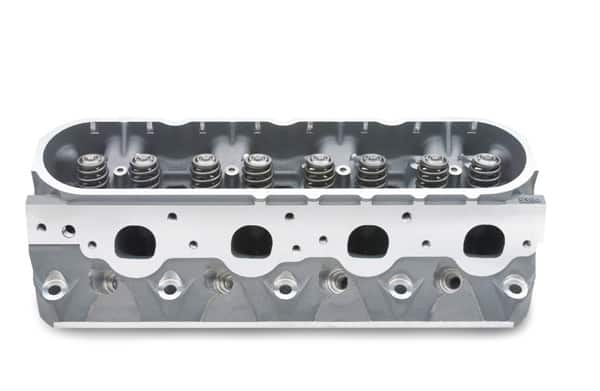
- 12 degree (LS7) vs 15 degree (LS3 / L92) valve angle
- Higher intake runner (LS7) which improves the airflow path while at the same time requiring a longer valve and greater unsupported stem area between the valve head and the bottom of the guide.
- 1.8:1 rocker arm ratio vs the 1.7:1 ratio found on its LS counterparts
- Ultra-light weight titanium intake valve and a hollow sodium filled exhaust valve.
We don’t feel the smoking gun is found in any one of these differences – but, some of them culminate to create the issue that keeps so many LS7 owners awake a night.
GM’S RESPONSE
General Motors released a technical service bulletin stating:

…it was determined that a machining error in the valve guide had occurred at our head supplier.
I have a hard time buying into this one – as I seriously doubt they finished the guides in the shape of an oval (as we find in a typical “out of spec” LS7 guide).
At minimum Ford would complain about logo infringement…
TOP 3 THEORIES WHY LS7’S FAIL
THEORY #1: HIGH LIFT CAMS & STOCK ROCKER ARMS
When we looked closely at the rocker to valve tip sweep pattern we find the stock steel radiused rocker takes a trip across over 60% of the of the valve tip or lash cap as it were.
It’s a simple and light design that works fairly well when the valve lift stays under .600 as GM intended. When we increase that lift however, the valve is subjected to greater side loading.
Effect: Sideloading on the valve, causing additional wear.
THEORY #2: EXCESSIVE VALVE COATING WEAR
The next theory is that the manufacturer of the titanium intake valves failed to get the chromium nitride coating right in some instances – resulting in the increased guide wear.
While it’s true that titanium hates everything except titanium, I am more prone to believe the coating simply wears through due to excessive side load, which then allows the titanium to go to work on the remaining guide.
Effect: Increased abrasion from exposed titanium.
THEORY #3: LONGER VALVES, SAME LENGTH GUIDES
In our opinion the third contributing factor is the length of the guide versus the length of the valve. The guide is the same length as the Other LS engines but the valves are longer. Nearly all the additional length is between the bottom of the guide and the valve seat.

Effect: You get the idea…
TOP 3 WAY TO BULLETPROOF YOUR LS7
RESOLUTION PT. 1: EXTEND THE VALVE GUIDE

We have found no appreciable flow reduction after extending the guide an additional .250 into the runner providing additional stability.
RESOLUTION PT. 2: IMPROVED GUIDE MATERIALS
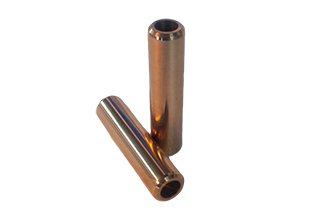
Concerning the guide material, the powdered metal guide is a very durable material that works extremely well on LS heads everywhere. On a street engine that doesn’t get torn down every season it is far superior to a standard bronze guide.
We feel the material itself is not a contributing factor, however manganese bronzanium 90 guides extended further into the port have proven an excellent solution during our endurance testing.
RESOLUTION PT. 3: UPGRADED ROCKER ARMS

Rocker arms play a major role in a high performance valve train and also come at a price, currency being one form and mass being the other.
We have studied most of the options currently available for the LS7 and will attempt to provide some insight.
A roller tip rocker when in a proper geometric configuration does a phenominal job of reducing side load on the guide and directing most of the energy towards the task of opening the valve. In high performance and racing applications where cost and complexity aren’t as negative a factor as in mass production manufacturing they are very desirable.
The challenge on the LS engine however is:
- designing a rugged component within the space constraints of the valve cover rails and height
- designing a structure that can properly support a roller and axle without adding a lot of mass between the fulcrum and the tip – which ultimately must be controlled by the valve spring
Roller Rockers (Shaft mount)
For solid roller applications, the shaft mount offerings from Jessel and Crower are our picks (as the mounting girdle distributes the load more reliably over the head casting vs. the cast stand bearing the burden).
We run:
- Jessel on OEM style castings after milling the stands down
- Crower on Brodix BR-7 big spring castings
Roller Rockers (Bolt on)
Concerning the bolt on products available we have tested Harlan Sharp, T&D, and Yellow Terra.
(Jessel offers a bolt on piece but when given the option of buying a vacation home on the coast or a set of rockers for testing, we had to make a choice. Seriously. $200.00 per rocker!)
We checked net lift on all the brands and found the sweep pattern and ratios to be acceptable. All slightly over ratio as I am sure is by design. Most customers won’t take issue with a tic more lift but don’t give them less!
Harlan Sharp
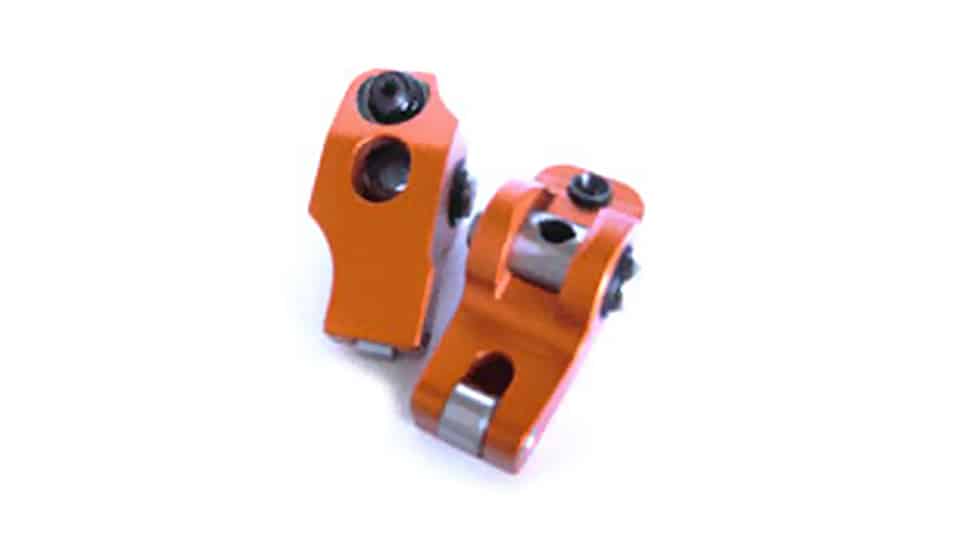
Out of the three, the bulky aluminum body Harlan Sharp SLS78A, was the only true bolt in so far as not having to clearance anything on the stock casting. We did have to dust a corner off with the belt sander on two end intakes and two exhausts when using on a BR-7 casting due to a slight difference in the valve cover rail.
These are a fully adjustable rocker and can be used with a solid roller. They will require a taller valve cover as do all of the adjustable solutions.
T & D
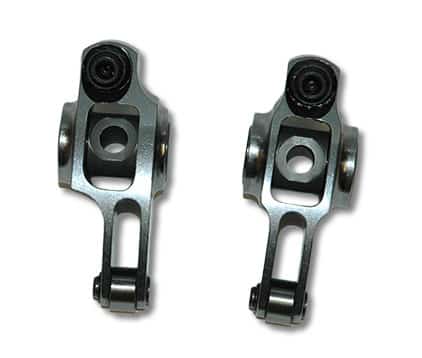
The T&D 15015 stock eliminator rockers are more expensive, but are a very nice piece. Billet steel construction yet very light where it counts. We had to clearance the upper valve cover rail even on stock castings, otherwise they are good to go.
Yellow Terra
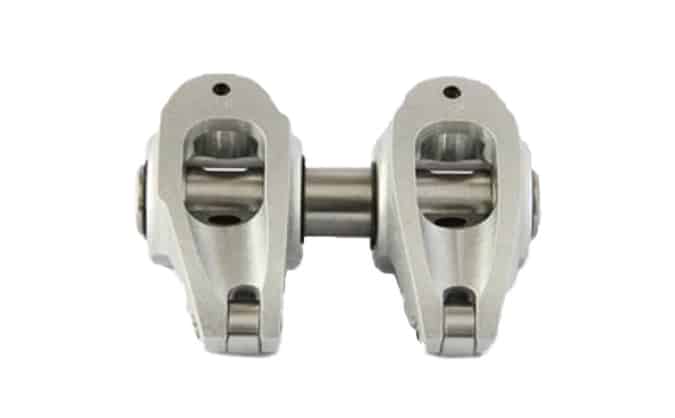
The Yellow Terra which is advertised as retaining the stock cover was a bit more of a challenge. They are non adjustable and use a .125 thick hex nut and a thicker gasket to gain the needed cover clearance. I tested them on a .648 lift set up by putting a dial indicator on the cover and rolling the engine over using the stock gasket and measured .152 movement, so the math tells me a valve cover spacer or tall cover would be necessary.
The other issue we ran into was we had to relieve one side of the bottom of the stand otherwise they lock up when they get close to seating on the stand. We tried 2 different sets of castings and one set was worse than the other but both needed some work. I am sure due to some core shift it’s not the case on every set of heads but still noteworthy.
IN CONCLUSION
The way we sleep best at night as it relates to LS7 top ends is as follows:
- Valve Guides:
- Powdered Metal Guide or Bronzanium 90 Guides
- .250 longer properly fit to spec
- Rocker Arms:
- If stock rockers are used:
- Lift at .630″ or less, and true the tips.
- Micro-polished and bronze bushed is a nice option on the stock rockers – although we have seen few GM trunnion bearing failures where some type of trauma was not the root cause. (We have seen more failures with the trunnion bearing kits where the trunnion material doesn’t appear hard and or smooth enough to act as a bearing race. The OEM bearings have a hardened steel inner race to provide the needle bearings a nice surface to run on. For that reason we sell only bushing kits).
- If roller rockers are used:
- Refer to our findings provided earlier.
- If stock rockers are used:
- Intake Valves:
- Polish and coat the original Del West intake valves.
- Exhaust Valves:
- REV offers a nice solid stainless 1.614 exhaust valve that’s affordable and totally adequate for most street applications. (It weighs in about 18 grams heavier than the F2042P but is still under 100 grams).
- Ferrea F-2042P-8 exhaust valves for N/A applications.
- We like the Ferrea F-1597P-8 for forced induction applications.
- Valve springs:
- Will vary with intended use and cam spec.
- Lash Caps:
- Don’t forget the lash caps on the Del West Titanium intake valves.
CHECK OUT OUR COMPLETE LS7 PACKAGE!
Our LS7 Cylinder Head Package solves all of these durability concerns – while improving power and torque across the power band. If you are a concerned LS7 owner – this is a no brainer.
-
 GPI – LS7 HeadsFrom: $1,195.00
GPI – LS7 HeadsFrom: $1,195.00

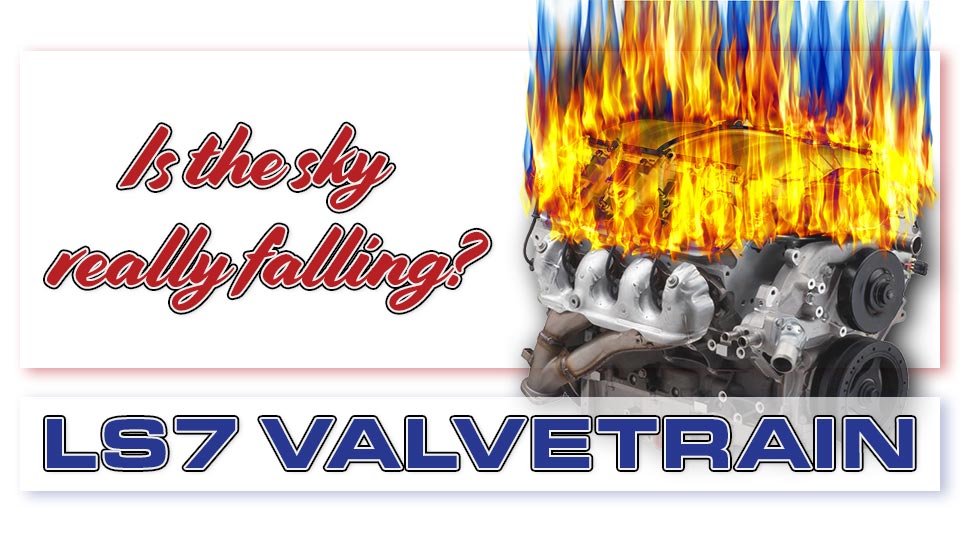
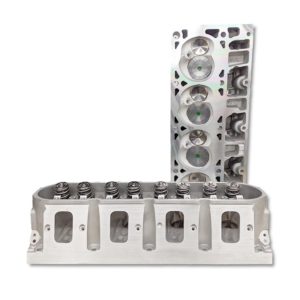
I have a 2006 Z06 which I bought in March 2006. I have put 70,000 miles on it and have not had one problem with the valve train. The car is bone stock. I made 3 passes at the local drag strip in 2007 on Nitto Extreme drag radials and have done a few parade laps turning into hot laps at several east coast tracks. That’s it, no problems. What would you do, nothing or get the heads redone? Dave E.
Ultimately its up to you but to be on the precautious side I would have them revised to avoid any other potential future damage
I bought the CNC’d LS9 heads for my LS3. The LS9 also had titanium intakes and sodium filled exhaust, although smaller valves than the LS7. No issues with the LS9 heads.
The valve coating would be the same between the two engines, so the 12 degree and longer valve of the LS7 must be the culprit.
Once again, great article!
I had a completely stock 2008 with 19,000 miles when it dropped a valve and blew the engine. It had never seen a track mile. This does indeed happen to non-modified engines.
Has anyone narrowed down the model years this has been occuring?
Of those model years what is the percentage of affected engines ?
It seems some owners have seen no problems whatsoever , even after many odometer miles.
My son’s 2007 Z06 dropped a valve after the previous owner had a cam installed and did some head work. The shop that did the work only installed 2 lash caps on the 8 titanium valves. One stem wore through in a very short time leaving the rocker riding directly on the titanium retainer. Once that happened, it dropped a valve and trashed the entire engine. Only one cylinder head was salvageable. Great article but nothing was mentioned about lash caps. If head work is done and the titanium valves retained, be sure the shop doing the work is competent and knows to re-install the lash caps.
If you do blow and engine, replace the oil cooler. Don’t try to flush it, you won’t get all of the debris out. We are dealing with that on the new engine. The shop that did the install thought they could flush it with a couple of cans of carburetor cleaner and we had to tear the new engine down to replace the bearings among other things.
Sorry so long winded but if it saves someone the grief we have gone through it’s worth the time.
My Experience says different. My stock 2007 Z06 LS7 dropped a valve and blew the engine. There are numerous reports of blown stock LS7’s. Get the heads rebuilt!